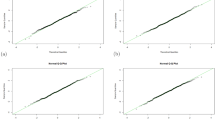Abstract
The paper formulates joint modeling of a counting process and a sequence of longitudinal measurements, governed by a common latent stochastic process. The latent process is modeled as a function of explanatory variables and a Brownian motion process. The conditional likelihood given values of the latent process at the measurement times, has been drawn using Brownian bridge properties; then integrating over all possible values of the latent process at the measurement times leads to the desired joint likelihood. An estimation procedure using joint likelihood and a numerical optimization is described. The method is applied to the study of cognitive decline and Alzheimer's disease.
Similar content being viewed by others
References
O. O. Aalen and H. K. Gjessing, “Understanding the shape of the hazard rate: A process point of view,” Statistical Science vol. 16 pp. 1–22, 2001.
D. Commenges, L. Letenneur, P. Joly, A. Alioum, and J. F. Dartigues, “Modelling age-specific risk: Application to dementia,” Statistics in Medicine vol. 17 pp. 1973–1988, 1998.
D. R. Cox, “Some remarks on failure-times, surrogate markers, degradation, wear, and the quality of life,” Lifetime Data Analysis vol. 5 pp. 307–314, 1999.
M. Evans and T. Swartz, Approximating Integrals via Monte Carlo and Deterministic Methods, Oxford University Press: Oxford, 2000.
P. Diggle, “An approach to the analysis of repeated measurements,” Biometrics vol. 44 pp. 959–971, 1988.
C. L. Faucett and D. C. Thomas, “Simultaneously modelling censored survival data and repeatedly measured covariates: A Gibbs sampling approach,” Statistics in Medicine vol. 15 pp. 1663–1685, 1996.
M. F. Folstein, S. E. Folstein, and P. R. McHugh, “Mini-mental state. A practical method for grading the cognitive state of patients for the clinician,” J Psychiatr Res vol. 12 pp. 189–198, 1975.
R. Henderson, P. Diggle, and A. Dobson, “Joint modeling of longitudinal measurements and event time data,” Biostatistics vol. 1 pp. 465–480, 2000.
J. W. Hogan and N. M. Laird, “Model-based approaches to analysing incomplete longitudinal and failure time data,” Statistics in Medicine vol. 16 pp. 259–272, 1997.
H. Jacqmin-Gadda, C. Fabrigoule, D. Commenges, and J. F. Dartigues, “A 5-year longitudinal study of the mini-mental state examination in normal aging,” American Journal of Epidemiology vol. 145 pp. 498–506, 1997.
P. Joly, D. Commenges, C. Helmer, and L. Letenneur, “A penalized likelihood approach for an illness-death model with interval-censored data: application to age-specific incidence of dementia,” Biostatistics vol. 3 pp. 433–443, 2002.
I. Karatzas and S. E. Shreve, Brownian Motion and Stochastic Calculus, second edition, Springer-Verlag: New-York, 1991.
F. C. Klebaner, Introduction to Stochastic Calculus with Applications, Imperial College Press: London, 1998.
M. L. T. Lee, V. DeGruttola, and D. Schoenfeld, “A model for markers and latent health status,” Journal of Royal Statistical Society: Series B vol. 62 pp. 747–762, 2000.
L. Letenneur, V. Gilleron, D. Commenges, C. Helmer, J. M. Orgogozo, and J. F. Dartigues, “Are sex and educational level independent predictors of dementia and Alzheimer's disease? Incidence data from the Paquid project,” Journal of Neurology Neurosurgery and Psychiatry vol. 6 pp. 177–183, 1999.
D. V. Lindley, Bayesian Statistics, A Review, SIAM Philadelphia, PA, 1971.
D. Marquardt, “An algorithm for least-squares estimation of nonlinear parameters,” SIAM Journal of Applied Mathematics pp. 431–441, 1963.
G. A. Whitmore, M. J. Crowder, and J. F. Lawless, “Failure inference from a marker process based on a bivariate Wiener model,” Lifetime Data Analysis vol. 4 pp. 229–251, 1998.
M. S. Wulfsohn and A. A. Tsiatis, “A joint model for survival and longitudinal data measured with error,” Biometrics vol. 53 pp. 330–339, 1997.
Author information
Authors and Affiliations
Rights and permissions
About this article
Cite this article
Hashemi, R., Jacqmin-Gadda, H. & Commenges, D. A Latent Process Model for Joint Modeling of Events and Marker. Lifetime Data Anal 9, 331–343 (2003). https://doi.org/10.1023/B:LIDA.0000012420.36627.a6
Issue Date:
DOI: https://doi.org/10.1023/B:LIDA.0000012420.36627.a6



